Everyone wants to slow down, breathe, and find peace. Yet, in a world filled with constant notifications and daily stress, achieving mindfulness isn’t always easy.
That’s where meditation apps like Headspace and Calm step in, helping millions of users build balance and focus through guided, accessible sessions.
Interestingly, the global meditation app market is projected to surpass $6 billion by 2026, reflecting the rapid evolution of wellness tech (Statista).
So, what makes these apps so effective? Is it their calming design, intelligent personalization, or the psychology that keeps users coming back?
As more people look for mindful solutions to manage stress, businesses now have a real opportunity to create digital tools that make relaxation part of everyday life.
In this blog, we’ll explore what it takes to build a meditation app like Headspace or Calm.
- The essential features
- Tech stack
- Development steps
- Cost factors
So, let’s get started!
Why Should You Consider Building a Meditation App in 2026?
Meditation apps are growing in popularity as people seek convenient ways to manage stress, improve focus, and sleep better. By 2026, the global meditation app market is expected to reach billions of dollars, showing strong demand.
Table of Contents
Apps like Headspace and Calm have proven that accessible, guided mindfulness experiences attract loyal users. Building a meditation app lets you deliver value through features like guided sessions, reminders, and progress tracking, while also creating opportunities for subscriptions or premium content.
What Are the Key Steps to Develop a Meditation App Like Headspace or Calm?
Creating a meditation app goes beyond coding. It’s about crafting a serene, user-friendly experience that helps people relax, focus, and build mindful habits. Every step, from planning to launch, plays a vital role in making the app not just functional but genuinely calming and enjoyable for users.
Here’s a clear roadmap to guide the process:
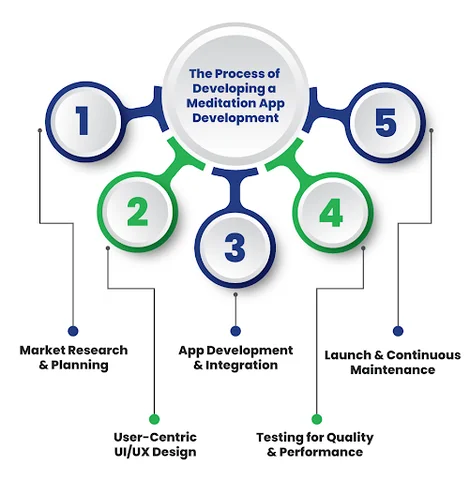
1. Market Research and Planning
Identify your target audience and analyze existing apps to understand what works and what doesn’t. Defining your app’s unique value early on helps create a focused roadmap and sets the foundation for a user-centered experience.
2. UI/UX Design
Create a calming and intuitive interface by focusing on soft colors, minimal visuals, and smooth navigation. Prioritizing user-centered design ensures a distraction-free environment that encourages consistent engagement, in line with best practices in professional UI/UX design services.
3. App Development and Testing
Use your chosen tech stack to build the app, integrate audio features, and test for performance, bugs, and user experience. Comprehensive testing for performance, usability, and potential bugs is essential to ensure a smooth and reliable user experience, reflecting the principles of thorough Software Quality Assurance & Testing Services.
4. Launch and Maintenance
Deploy the app and gather user feedback to identify areas for improvement. Continuous updates and feature enhancements ensure the app stays relevant, functional, and aligned with user needs over time.
Now, let’s look at the key features of the meditation apps that make these platforms successful.
What Are the Essential Features of a Successful Meditation App?
Meditation apps stand out when they offer features that truly support users on their mindfulness journey. The correct combination of tools, from progress tracking to guided sessions, keeps users engaged and consistent.
Let’s look at the essential features for a meditation app that make top apps like Headspace and Calm so effective.
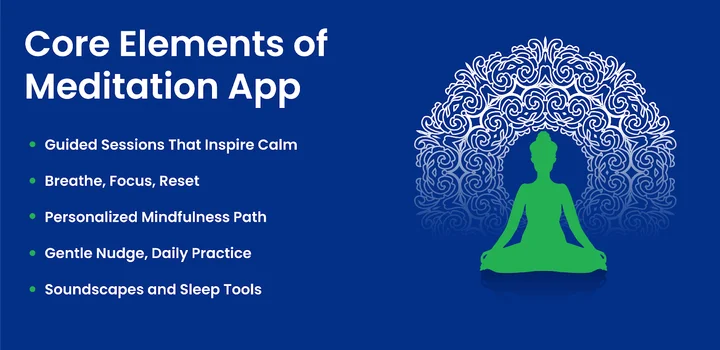
1. Guided Meditation Sessions
These are the heart of any mindfulness app development project. Offer users audio and video sessions led by experts, covering topics such as stress relief, focus, sleep, and anxiety management. You can also categorize sessions by duration (5–30 minutes) or skill level (beginner to advanced) to make it easy for users to choose options that fit their schedule.
2. Mindfulness and Breathing Exercises
Add short, on-demand exercises that help users reset throughout the day. This could include breathing timers, focus breaks, or quick mindfulness activities. Integrating calming animations or visuals can make the experience even more engaging and become an essential part of the calm app features.
3. Progress Tracking and Analytics
Users love seeing their growth. Include dashboards showing total meditation minutes, streaks, session history, and mood improvements. These user engagement features in meditation apps are critical for retention.
4. Personalized Recommendations
AI-based personalization can enhance engagement by suggesting new sessions based on a user’s activity, goals, and emotional patterns. For instance, if someone often selects “sleep” meditations, the app could recommend bedtime stories or calming soundscapes automatically.
5. Notifications and Reminders
Timely nudges can make or break user habits. Smart reminders, such as gentle notifications to meditate at preferred times, help users maintain their routine without feeling pressured. Add customization options so users can choose how often they receive reminders.
Most meditation apps struggle to balance calm design with real user engagement. Build one that truly helps people relax, focus, and return every day for more peace.
Which Tech Stack Should You Use to Build a Meditation App?
The meditation app tech stack forms the backbone of your app. A robust, reliable tech stack ensures smooth performance, supports real-time audio, and enables your app to scale as your user base grows.
The ideal tech stack for creating meditation apps is as follows:

1. Frontend Technologies
Cross-platform frameworks like React Native and Flutter are effective for developing meditation apps.
- React Native offers a native-like experience and speeds up development with reusable components.
- Flutter, developed by Google, provides fluid animations and a consistent interface, which suits the calm and immersive nature of meditation apps.
Hiring skilled React developers or Flutter developers ensures your meditation app delivers a smooth, engaging, and serene experience for users.
2. Backend Technologies
On the backend, frameworks like Node.js, Python (Django or Flask), and Ruby on Rails are ideal for Headspace app development and other scalable projects and provide secure and scalable architectures.
- Node.js works well for handling real-time features such as live audio or meditation sessions.
- Python supports advanced functionalities like AI-based recommendations and progress tracking.
- Ruby on Rails allows quick, structured development with built-in security features.
Ultimately, well-planned backend development ties these technologies together, enabling the Headspace app development to deliver consistent performance and a seamless user experience.
3. Third-Party Integrations
Adding external services enhances both functionality and user engagement.
- Firebase can manage analytics, authentication, and real-time data sync.
- Twilio is effective for notifications and user reminders.
- Stripe simplifies in-app payments and subscription management.
Together, a well-chosen tech stack ensures that your meditation app performs efficiently, remains secure, and delivers a relaxing, uninterrupted experience to every user.
What Factors Influence the Cost of Developing a Meditation App?
When estimating the cost of a meditation app, several factors come into play. From the app’s complexity to the tech stack and feature set. The total investment can vary greatly depending on your goals, target audience, and the overall user experience you want to deliver.
Let’s break down the factors that shape development costs and see how each affects your budget.
1. App Features and Complexity
Your app’s features are the most significant cost driver.
- A basic app with guided meditations, login, and a simple dashboard typically costs $15,000–$25,000.
- Adding advanced features like personalized recommendations, AI mood tracking, or wearable device integration can raise costs to $40,000–$70,000+.
The more complex the functionality, the more development hours are required, which directly impacts the overall cost.

2. Design and User Experience
Meditation apps rely on clean, calming visuals to deliver a peaceful experience.
- A standard design may range from $3,000 to $7,000.
- A custom UI/UX with animations, illustrations, and premium aesthetics can cost $10,000 or more.
Since users expect a soothing interface, investing in a well-crafted design improves retention and satisfaction.
3. Platform Choice (iOS, Android, or Both)
Building for one platform is more affordable but limits reach.
- Single platform (iOS or Android): around $15,000–$25,000.
- Both platforms (native apps): between $30,000 and $50,000+.
If you’re targeting both iOS and Android, cross-platform frameworks like Flutter or React Native can help lower app development costs while maintaining performance.
4. Development Team and Location
Pricing is also impacted by who develops your app and where they are located.
- Teams in the U.S. or Europe often charge $80–$150/hour.
- Teams in South Asia or Eastern Europe usually charge $30–$60/hour.
A full-featured meditation app built by an experienced offshore team may cost between $25,000 and $50,000, depending on complexity and project timeline.
5. Maintenance and Updates
The work doesn’t stop after launch. Regular updates, new content, and bug fixes ensure your app stays relevant and reliable.
- Expect to spend about 15–20% of the initial development cost annually on maintenance.
- For instance, if your app costs $40,000 to build, set aside $6,000–$8,000 per year for improvements and optimizations.
Continuous maintenance keeps your app performing well and your users satisfied.
Before wrapping up, here are some common questions entrepreneurs often ask when planning a meditation app.
Frequently Asked Questions (FAQs)
2. Can I monetize my meditation app?
Yes, absolutely! Popular monetization strategies include:
- Freemium model: Offer introductory sessions for free and charge for premium content.
- Subscriptions: Monthly or yearly plans for unlimited access.
- In-app purchases: Users can buy individual meditation packs or soundscapes.
- Partnerships & collaborations: Work with wellness coaches or brands for sponsored content.
Your audience and long-term objectives will determine which model is best for you.
3. Do I need a background in wellness or psychology to launch a meditation app?
Not necessarily. While expertise helps create authentic and compelling content, you can collaborate with mindfulness experts, therapists, or meditation coaches to design sessions. Your primary focus should be building a smooth, calming, and user-friendly digital experience. The content can be developed in partnership with professionals.
4. How can you make your meditation app stand out from competitors?
To stand out, focus on:
- Personalization: Use AI to adapt content to the user’s mood or goals.
- Unique content themes: Offer niche meditations like “mindfulness for students” or “5-minute stress breaks.”
- Community features: Add group challenges or live meditation events.
- Integration: Sync with wearables or smart devices for progress tracking.
Innovation and empathy are the keys to differentiation in the wellness market.
Wrapping Up: Your Roadmap to a Successful Meditation App
Every great meditation app starts with a simple idea: to help people find peace, focus, and balance in their everyday lives.
But how do you turn that idea into a product users genuinely connect with?
The answer lies in thoughtful design, the right tech stack, and a clear development roadmap that aligns with both user expectations and business goals.
If you’re planning to bring your mindfulness vision to life, start by focusing on what truly matters: user experience, accessibility, and long-term engagement. With the right mobile app development Services approach, you can transform your concept into an app that not only guides users through meditation but also becomes a daily part of their well-being journey.
So, what’s your next step?
Now is the ideal time to start, whether that means creating your first wireframe, finalizing your tech stack, or selecting the best team to bring your product to life. After all, every successful app, like every moment of mindfulness, begins with a single, intentional breath.
Having trouble turning your meditation app into a top-ranking hit? With the right strategy and tech stack, you can build an experience that inspires calm and lasting engagement.


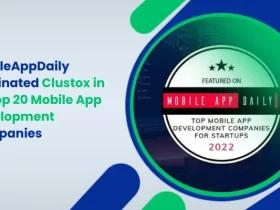
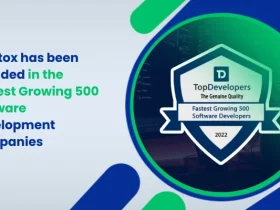
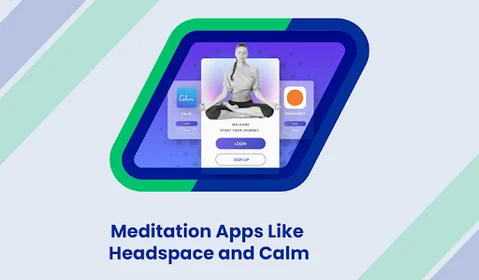
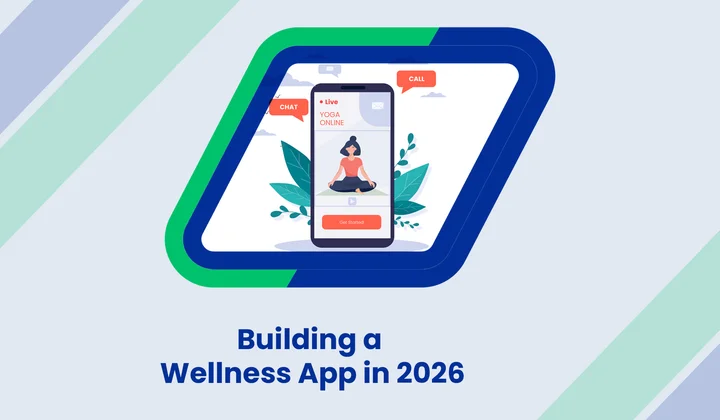

Share your thoughts about this blog!